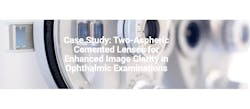Case Study: Two-Aspheric Cemented Lenses for Enhanced Image Clarity in Ophthalmic Examinations
- Avantier manufactures a two-aspheric cemented lens by combining two aspheric lenses, which corrects aberrations and enhances optical performance.
- Specifically designed for innovative eyepieces in ophthalmic examinations, these lenses excel in minimizing distortions to improve image quality and clarity, making them suitable for various fields.
- The project focused on achieving high surface accuracy, different types of surface figures, and high surface quality.
- Despite the challenges of perfecting the fit of two-aspheric lenses, Avantier’s commitment to excellence in lens production is demonstrated through higher processing precision and overall quality.
Introduction
This two-aspheric cemented lens, a significant advancement in the field of optical design, represents a technological marvel in optics. Unlike traditional lenses, these innovative optical components are manufactured by combining two aspheric lenses together, providing unique advantages in correcting aberrations and enhancing optical performance.
One of the primary reasons for developing aspheric cemented lenses is to more effectively address chromatic and spherical aberrations. By employing advanced design principles, these lenses excel in minimizing distortions, thereby improving image quality and clarity. This characteristic makes them particularly well-suited for various fields.
The structure of aspheric cemented lenses involves the precise cementing of two distinct optical elements. Whether through cementing or assembly, lenses produced through this process can generate smaller spot sizes compared to equivalent single lenses. The reduction of aberrations and improvement in optical performance make aspheric lenses the preferred choice in various fields requiring precision and high image quality.
Project Overview
These two-aspheric cemented lenses are specifically designed for innovative eyepieces in ophthalmic examinations. They are versatile, suitable not only for large fixed equipment but also seamlessly adaptable to convenient head-mounted devices. The design incorporates aspheric curvature to optimize the lens performance. By employing this advanced design, it effectively reduces or eliminates aberrations that traditional spherical lenses may cause, significantly enhancing the imaging quality in ophthalmic examinations.
This innovative design holds the promise of delivering more accurate and clear observation results in the field of ophthalmology, empowering eye care professionals with exceptional diagnostic and therapeutic capabilities. Whether utilized with large-scale equipment or portable head-mounted devices, these two-aspheric cemented lenses serve as advanced and efficient tools for medical practices in the field of ophthalmology.
